- 100% original finish, everywhere
- Scale length: 13 inches
- Nut width: 1 1/8 inches
- Serial number: 38764
-
 The Larson Brothers need little introduction to the world’s top players and collectors, and they are very different instruments from the Martin and Gibson instruments that dominated the 1920’s and 30’s by their shear numbers. Larson instruments are rising in value rapidly, as they never produced the kind of volume that Martin much less Gibson produced in those decades, and they are now recognized for their magnificent workmanship and tone. The now legendary Chicago-based Larson brothers, August and Carl, did not make instruments with a “Larson” label. All of their instruments were branded and marketed for Stahl, Maurer, Prairie State, Euphonon, Dyer, Bruno, and a few more. Yet every one of their instruments has their unmistakable trademarks. And their unmistakable tone. This exquisitely beautiful, 100% original Larson Mandolin was made at the very height of the Larson legacy– when they were making their finest instruments. It has all of the Larson trademarks that set apart the best Larsons, including “built under tension” design, and Larson’s classic “ebony under the binding” on the neck. Every part of this instrument is 100% original. And its crack-free– save for two tiny dryness finish cracks near center of back, of about two inches each.
The Larson Brothers need little introduction to the world’s top players and collectors, and they are very different instruments from the Martin and Gibson instruments that dominated the 1920’s and 30’s by their shear numbers. Larson instruments are rising in value rapidly, as they never produced the kind of volume that Martin much less Gibson produced in those decades, and they are now recognized for their magnificent workmanship and tone. The now legendary Chicago-based Larson brothers, August and Carl, did not make instruments with a “Larson” label. All of their instruments were branded and marketed for Stahl, Maurer, Prairie State, Euphonon, Dyer, Bruno, and a few more. Yet every one of their instruments has their unmistakable trademarks. And their unmistakable tone. This exquisitely beautiful, 100% original Larson Mandolin was made at the very height of the Larson legacy– when they were making their finest instruments. It has all of the Larson trademarks that set apart the best Larsons, including “built under tension” design, and Larson’s classic “ebony under the binding” on the neck. Every part of this instrument is 100% original. And its crack-free– save for two tiny dryness finish cracks near center of back, of about two inches each. -
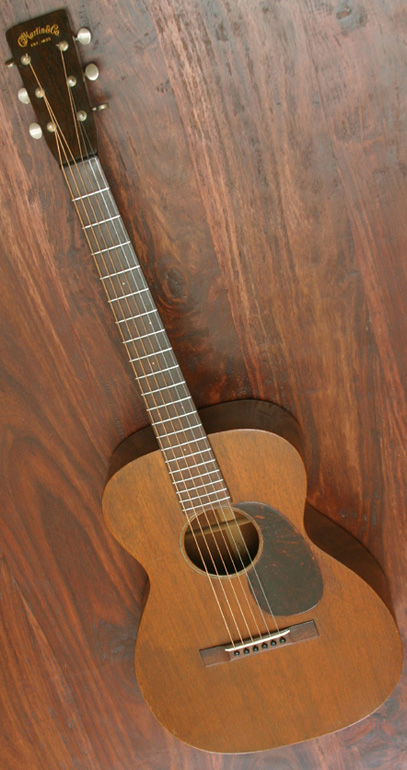 It’s rare to find a Golden Era Martin in this condition. This wonderful, completely crack-free 14-fret guitar from the 30’s is a gem. It’s one of the very first Martins of any style to have all three: 14 frets clear of body+Martin decal on the front of the peghead+Martin stamp the back of the peghead. Mahogany top, back and sides, of course, and it has the great, resonant feel and tone of a very lightly built 12-fret, but with more volume, in a 14-fret package. Strong bass response. 1 3/4 inch nut. Original finish, everywhere; no cracks anywhere. Original tuners. Original full-height bridge and maple bridge plate. Original bridge pins, and nut. The neck was recently set, so there is a new bone saddle, and the action is nice and low. Original bar frets. Some slight wear below the pick guard (not a hint of a crack or even any shrinking of the edges of the pick guard), and a variety of minor dings– but this completely crack-free guitar from the Martin Golden era is a gem.
It’s rare to find a Golden Era Martin in this condition. This wonderful, completely crack-free 14-fret guitar from the 30’s is a gem. It’s one of the very first Martins of any style to have all three: 14 frets clear of body+Martin decal on the front of the peghead+Martin stamp the back of the peghead. Mahogany top, back and sides, of course, and it has the great, resonant feel and tone of a very lightly built 12-fret, but with more volume, in a 14-fret package. Strong bass response. 1 3/4 inch nut. Original finish, everywhere; no cracks anywhere. Original tuners. Original full-height bridge and maple bridge plate. Original bridge pins, and nut. The neck was recently set, so there is a new bone saddle, and the action is nice and low. Original bar frets. Some slight wear below the pick guard (not a hint of a crack or even any shrinking of the edges of the pick guard), and a variety of minor dings– but this completely crack-free guitar from the Martin Golden era is a gem. -
Out of stock
 The Larson Brothers of Chicago never marketed any guitar, throughout their long career, that was marked “Larson”. Their designs were branded by Maurer, Stahl, Prairie State, Stetson, and a few other guitar makers– but never “Larson”. They were also known for making many “off-catalog” guitars, i.e. guitars with combinations of features that varied from the Maurer, Stahl, etc, catalogs, and guitars that were not marked at all with a brand. This guitar is a Larson Bros creation that is not marked at all. It is a custom made instrument–but it has all the typical Larson hallmarks. The tone of this Larson is every bit as wonderful as the Maurer/Larson listed above, indeed it is quite similar, due to the same patented “built under tension” design, and X-bracing. This Larson does not have laminated braces (it’s well documented that laminated braces were only used on certain models–and their use was not related to level or price.) Every part of this guitar is original, including original finish. There are two repaired cracks on the back, and three small, repaired cracks on top.
The Larson Brothers of Chicago never marketed any guitar, throughout their long career, that was marked “Larson”. Their designs were branded by Maurer, Stahl, Prairie State, Stetson, and a few other guitar makers– but never “Larson”. They were also known for making many “off-catalog” guitars, i.e. guitars with combinations of features that varied from the Maurer, Stahl, etc, catalogs, and guitars that were not marked at all with a brand. This guitar is a Larson Bros creation that is not marked at all. It is a custom made instrument–but it has all the typical Larson hallmarks. The tone of this Larson is every bit as wonderful as the Maurer/Larson listed above, indeed it is quite similar, due to the same patented “built under tension” design, and X-bracing. This Larson does not have laminated braces (it’s well documented that laminated braces were only used on certain models–and their use was not related to level or price.) Every part of this guitar is original, including original finish. There are two repaired cracks on the back, and three small, repaired cracks on top.- Lower bout width: 12 5/8 inches
- Brazilian rosewood back and sides
- Ivory celluloid Bound fretboard
- Ivory celluloid Bound headstock
- Spruce top
- X braced
- Larson’s patented “built under tension” design
- Rosette: Abalone pearl and wood inlay bordering the sound hole
- Radiused ebony fingerboard, and Classic Larson Brothers’ “ebony below the binding”
- Engraved inlays on fretboard
- Original tuners
- Original ebony bridge
- Original bridge pins
- 1-7/8" wide nut
- 2 1/4" bridge string spacing
- 24.3" scale length
- One-piece mahogany neck, round C shaped neck profile.
-
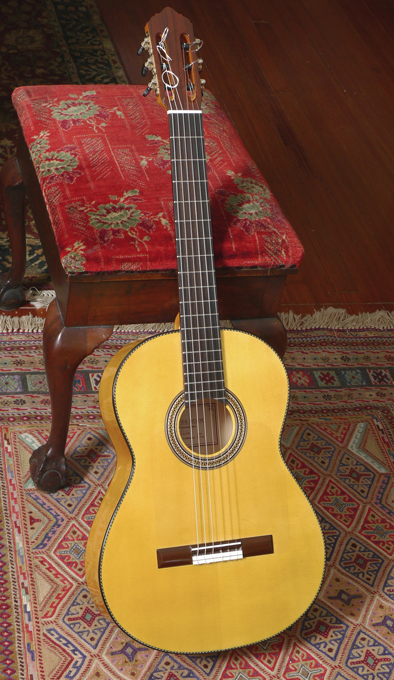 Brand new, Lester Devoe Flamenco Blanca, custom made (details on request). Lester Devoe needs no introduction to the world’s top flamenco players. His reputation was established decades ago (and his new models are the best ever made, and in huge demand worldwide). His guitars are played by the world’s top performing and recording flamenco artists. This instrument, custom made with a unique Spanish Cypress to add a more robust treble response to the legendary deep, throaty, percussive bass response of the Devoe Blanca, will amaze.
Brand new, Lester Devoe Flamenco Blanca, custom made (details on request). Lester Devoe needs no introduction to the world’s top flamenco players. His reputation was established decades ago (and his new models are the best ever made, and in huge demand worldwide). His guitars are played by the world’s top performing and recording flamenco artists. This instrument, custom made with a unique Spanish Cypress to add a more robust treble response to the legendary deep, throaty, percussive bass response of the Devoe Blanca, will amaze.- Flamenco Blanca
- 650mm scale length
- Spanish cypress back and sides (custom, details on request)
- European spruce top
- Ebony fingerboard
- Sloane tuners
- Rosewood headstock veneer
- Cedar neck
- Nitrocellulose lacquer finish
-
 100% crack-free, structurally perfect, this 00-28 is gold standard for 12 fret, pre-war Martin Brazilian Rosewood tone. Refinished to exquisite standards some 40 years ago, this 00-28 has some of the most stunning Brazilian rosewood ever used by Martin. This is the most beautiful, best sounding "Herringbone" prewar 00-28 we've seen. And with mileage on the finish, at the Arlington Guitar Show last fall, several top vintage guitar dealers were not sure if this wasn't the original finish on the guitar, it's that good. It is braced for steel strings. It has held steel strings for years, and not only are there no cracks or stress issues, there is no bellying behind the bridge. And if that’s not enough, there is a letter from Mike Longworth, signed by Longworth and dated 1984, documenting the guitar, and suggesting the use of steel strings on it. Condition:
100% crack-free, structurally perfect, this 00-28 is gold standard for 12 fret, pre-war Martin Brazilian Rosewood tone. Refinished to exquisite standards some 40 years ago, this 00-28 has some of the most stunning Brazilian rosewood ever used by Martin. This is the most beautiful, best sounding "Herringbone" prewar 00-28 we've seen. And with mileage on the finish, at the Arlington Guitar Show last fall, several top vintage guitar dealers were not sure if this wasn't the original finish on the guitar, it's that good. It is braced for steel strings. It has held steel strings for years, and not only are there no cracks or stress issues, there is no bellying behind the bridge. And if that’s not enough, there is a letter from Mike Longworth, signed by Longworth and dated 1984, documenting the guitar, and suggesting the use of steel strings on it. Condition:- No cracks anywhere.... Not a hint of a crack
- original bridge plate, in great condition
- original tuners
- original ivory bridge pins (the replacement bridge was made to accommodate these great original ivory bridge pins)
- Bridge is a perfect Brazilian Rosewood replacement, done by us, with old growth Brazilian.
- Saddle, and nut, carved from ivory (sourced by us, pre-CITES)
- Three very tiny screw holes above endpin from a previous tailpiece added and removed decades ago, were expertly filled by Tony Nobles–difficult to see more than a few inches away
- All the bar frets replaced by us (with Bar fret material from TJ Thomson), so it plays like a dream, with that full, cascading Brazilian tone that you'll only get from a fine 00-28
-
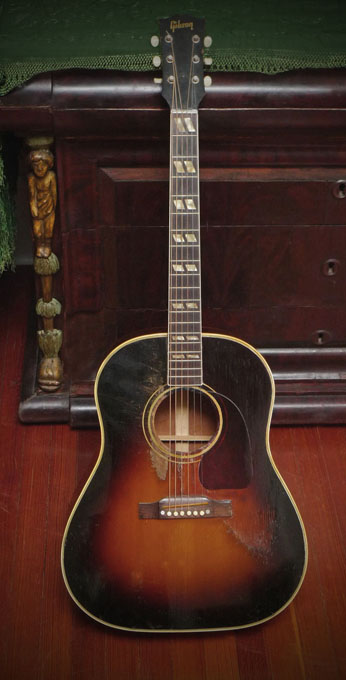 Crack-free, and superb tone. One of the finest sounding large bodied Gibsons we’ve ever heard.
Crack-free, and superb tone. One of the finest sounding large bodied Gibsons we’ve ever heard. -
 A wonderfully balanced and resonant Martin 00-28G, with some of the most beautiful Brazilian rosewood you’ll see on any Martin guitar, and in wonderful, crack-free, original condition. The Martin “G” is very different from the “C”. The “C” has the Martin 12 fret body. The “G” model used the 14-fret style body shape, but with the 12 fret neck, slotted headstock, and 25.4 inch scale. The 00-28G was first produced by Martin in 1936, and was discontinued in 1962, when Martin went to all “C” style for nylon string guitars. The 00-28G was Martin’s top of line model for nylon strings, from 1936, to 1962… and this guitar is the best example available on the market. The condition on this instrument is superb. No cracks anywhere, and very little wear at all... it's almost perfect. All original, tuners, nut, bridge, saddle, etc. Neck is perfect, has never been set, and shows perfect set up and action.
A wonderfully balanced and resonant Martin 00-28G, with some of the most beautiful Brazilian rosewood you’ll see on any Martin guitar, and in wonderful, crack-free, original condition. The Martin “G” is very different from the “C”. The “C” has the Martin 12 fret body. The “G” model used the 14-fret style body shape, but with the 12 fret neck, slotted headstock, and 25.4 inch scale. The 00-28G was first produced by Martin in 1936, and was discontinued in 1962, when Martin went to all “C” style for nylon string guitars. The 00-28G was Martin’s top of line model for nylon strings, from 1936, to 1962… and this guitar is the best example available on the market. The condition on this instrument is superb. No cracks anywhere, and very little wear at all... it's almost perfect. All original, tuners, nut, bridge, saddle, etc. Neck is perfect, has never been set, and shows perfect set up and action. -
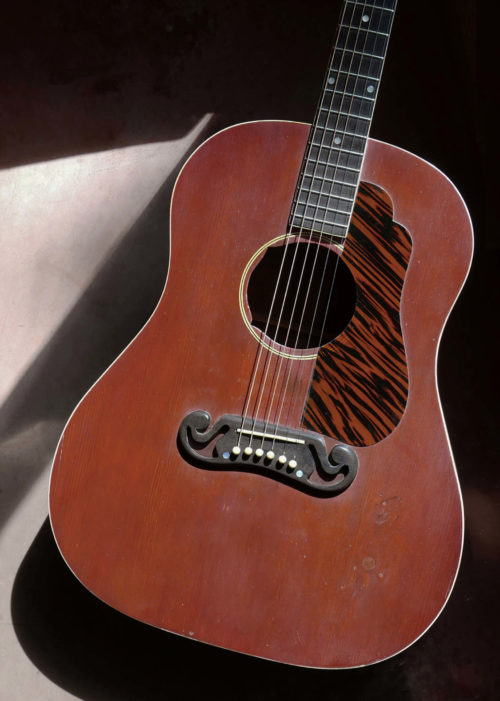 This is not your father’s J-55. And it’s not a $20K guitar. It is a wonderful player. This is an original 1939 Gibson Jumbo 55, also called the “J-55”, serial # EA5652. It is the rare, stair step headstock model, only made for a brief window in the late 30’s. It delivers the trademark, large body, prewar, long scale Gibson tone, like no other. It plays beautifully, with original bridge, frets, braces. This guitar has of course the original, Mustache bridge, and more rare– the stair step headstock. Original bridge plate. Original binding including on fretboard. Original pearl logo on the headstock (with original finish). The pickguard is a nitro cellulose reproduction meticulously crafted in our shop. It has the long scale, 25 ½ inches, that makes this model so great. And a little-known original feature of this rare model is that it has a 1 11/16 nut width, that combined with the low action makes it effortless to play, and with tone that cannot be equaled in any postwar Gibson. The intonation is spot-on, and the intonation and fretting/action are great even at the high fret positions. It was refinished in a deep Gibsonesque red, decades ago– and that makes this guitar the most affordable true 1939, stairstep headstock J-55 you will ever find. (Top thickness is fine, there was no thinning in the past). The tone is superb. And the action is superb– low and fast without sacrificing tone or volume at all.
This is not your father’s J-55. And it’s not a $20K guitar. It is a wonderful player. This is an original 1939 Gibson Jumbo 55, also called the “J-55”, serial # EA5652. It is the rare, stair step headstock model, only made for a brief window in the late 30’s. It delivers the trademark, large body, prewar, long scale Gibson tone, like no other. It plays beautifully, with original bridge, frets, braces. This guitar has of course the original, Mustache bridge, and more rare– the stair step headstock. Original bridge plate. Original binding including on fretboard. Original pearl logo on the headstock (with original finish). The pickguard is a nitro cellulose reproduction meticulously crafted in our shop. It has the long scale, 25 ½ inches, that makes this model so great. And a little-known original feature of this rare model is that it has a 1 11/16 nut width, that combined with the low action makes it effortless to play, and with tone that cannot be equaled in any postwar Gibson. The intonation is spot-on, and the intonation and fretting/action are great even at the high fret positions. It was refinished in a deep Gibsonesque red, decades ago– and that makes this guitar the most affordable true 1939, stairstep headstock J-55 you will ever find. (Top thickness is fine, there was no thinning in the past). The tone is superb. And the action is superb– low and fast without sacrificing tone or volume at all. -
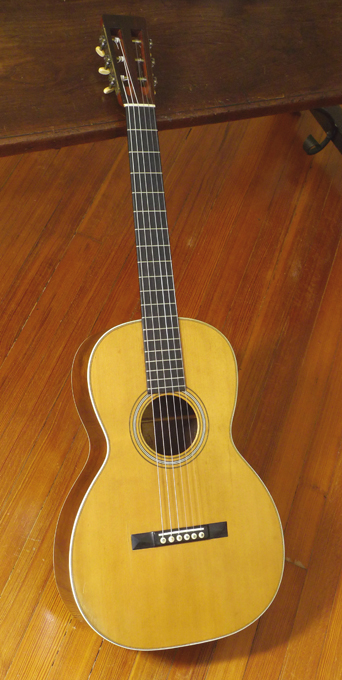 Signed by Martin factory foreman, underside of top: “Dec. 8, 1893”, this 0-28 is in wonderful original condition.
Signed by Martin factory foreman, underside of top: “Dec. 8, 1893”, this 0-28 is in wonderful original condition.- Instrument is 100% original: finish, bridge, ivory nut, ivory saddle, ivory bridge pins, bar frets
- Brazilian Rosewood Back and Sides
- Adirondack Spruce top
- Shows very little wear
- Scalloped braces (X-braced)
- Original maple bridge plate in perfect condition
- Original French-polish shellac finish throughout
- 13.5" wide at lower bout, and 4.25" deep at the endpin
- 24.9" scale length
- 1-7/8" wide nut
- Soft-V neck profile
- A couple small top cracks, professionally repaired and not an issue. Two finish checks/cracks, that due not go through wood, on back
-
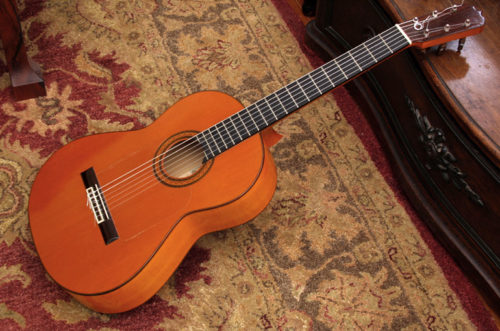 Martin established the X-brace as the standard in American guitars, but that was never pre-ordained, or set in stone. The fan-bracing of the Spanish guitar has equally appealing qualities, and is a century-plus long standard that continues to dominate the design of the classical and flamenco guitar. Not an “Estudio” (student) model, this is the top of line model, 1a Ramirez flamenco. If you’ve never played one of these exquisite cypress Ramirez flamenco guitars–you’ll be surprised at the tone. Spanish cypress back and sides. Cedar top. First of all, the guitar is so light. It floats in your hands, yet it’s tight as a drum. It’s one of the lightest guitars you will ever play (due to the lightness of the wood, and also to the use of tuning pegs–so that the head and neck of the guitar are not pulled down by gravity, allowing the head to float effortlessly at about eye level. And the raspy bass is unbelievable. It’s all about that percussive tone and throaty bass. Conventional wisdom says rosewood for a “classical” guitar, for sustain; and cypress for a flamenco guitar, for the percussive, throaty quality, and more volume. Action is low, as it should be for flamenco. And that wonderful wide nut (2-1/8 inch), you’ve got so much room to move on this beautiful ebony fingerboard. Original finish. As with almost all these old Ramirez flamencos with the tap plate on top, there are shallow, thin hairline cracks where the top edge, and bottom edge, of the tap plate (clear plastic) meets the top (similar to the small cracks you get on an old martin, due to the guard being glued to the top). There is also a six-inch long hairline finish crack on the top above and parallel to the fingerboard (does not go through the wood), and a 3-inch long hairline finish crack below the fingerboard. A few dings here and there, but finish is that original, beautiful high polish reddish-amber.
Martin established the X-brace as the standard in American guitars, but that was never pre-ordained, or set in stone. The fan-bracing of the Spanish guitar has equally appealing qualities, and is a century-plus long standard that continues to dominate the design of the classical and flamenco guitar. Not an “Estudio” (student) model, this is the top of line model, 1a Ramirez flamenco. If you’ve never played one of these exquisite cypress Ramirez flamenco guitars–you’ll be surprised at the tone. Spanish cypress back and sides. Cedar top. First of all, the guitar is so light. It floats in your hands, yet it’s tight as a drum. It’s one of the lightest guitars you will ever play (due to the lightness of the wood, and also to the use of tuning pegs–so that the head and neck of the guitar are not pulled down by gravity, allowing the head to float effortlessly at about eye level. And the raspy bass is unbelievable. It’s all about that percussive tone and throaty bass. Conventional wisdom says rosewood for a “classical” guitar, for sustain; and cypress for a flamenco guitar, for the percussive, throaty quality, and more volume. Action is low, as it should be for flamenco. And that wonderful wide nut (2-1/8 inch), you’ve got so much room to move on this beautiful ebony fingerboard. Original finish. As with almost all these old Ramirez flamencos with the tap plate on top, there are shallow, thin hairline cracks where the top edge, and bottom edge, of the tap plate (clear plastic) meets the top (similar to the small cracks you get on an old martin, due to the guard being glued to the top). There is also a six-inch long hairline finish crack on the top above and parallel to the fingerboard (does not go through the wood), and a 3-inch long hairline finish crack below the fingerboard. A few dings here and there, but finish is that original, beautiful high polish reddish-amber. -
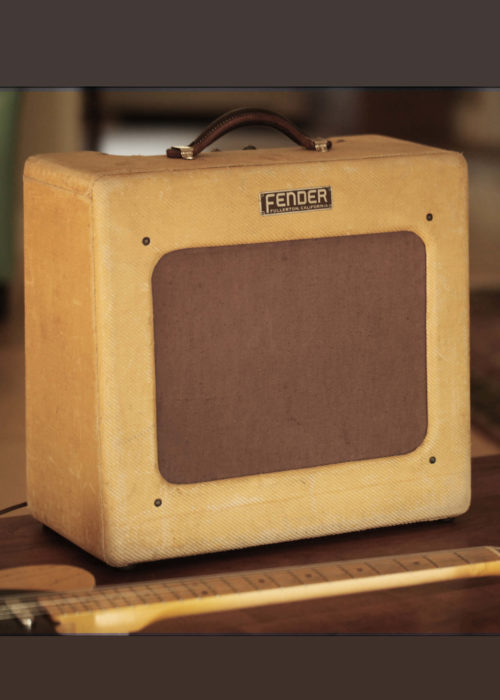 1951 Fender Deluxe Amplifier ... all it should be, and more... coming soon... . .
1951 Fender Deluxe Amplifier ... all it should be, and more... coming soon... . . -
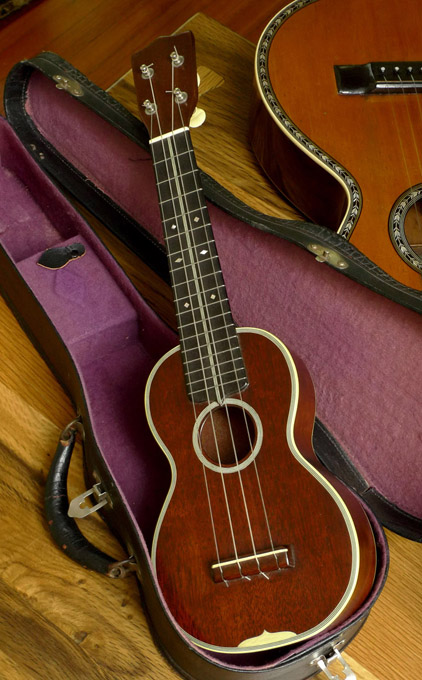 In the 1920’s and early 30's, the Hawaiian craze was in full bloom, and ukulele production was crucial to Martin’s success in this period. This is a wonderful, extremely well-preserved example of one of the most ornate of the Martin ukuleles, still in its original Geib case. Although Martin ukes built after 1916 carried no serial number, it’s possible to generally date them by stylistic elements. This Martin Style 3 is from the best era, the golden era, from about 1925 to 1930. Martin style 3 was first made in 1918. Martin Style 3, soprano (standard) specs:
In the 1920’s and early 30's, the Hawaiian craze was in full bloom, and ukulele production was crucial to Martin’s success in this period. This is a wonderful, extremely well-preserved example of one of the most ornate of the Martin ukuleles, still in its original Geib case. Although Martin ukes built after 1916 carried no serial number, it’s possible to generally date them by stylistic elements. This Martin Style 3 is from the best era, the golden era, from about 1925 to 1930. Martin style 3 was first made in 1918. Martin Style 3, soprano (standard) specs:- Mahogany body
- 7 layer top binding
- 3 layer back binding
- Ebony fretboard
- 5 layer soundhole ring
- Celluloid ornament on top, behind bridge (known as the "parend", or “shield”)
- Bar frets
- Small pearl paired-diamond inlays at fret 5, 7, and 9
- Three lines inlaid down center of fingerboard
- Nickel plated pegs (introduced in 1923)
- CF Martin & Co, stamped on back of peghead, and inside-back (Martin logo was not put on front of peghead until 1932)